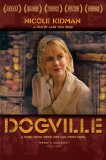Synopsis
The time is the Great Depression, and the setting is the isolated mountain village of Dogville.One night, a beautiful stranger named Grace (Nicole Kidman) arrives, pursued by gangsters.Would-be writer and pretentious pseudo-philosopher Tom (Paul Bettany) hides Grace, and thenpersuades the town to give her refuge. In order to win the townspeople over, Grace sets out tohelp each household for an hour each day. After some initial reluctance, the townspeopleembrace her and her …elp. Especially her help. Bit by bit, they exploit her more and more, untilthey become tyrannical, sexually abusive slave-masters. In the end, Grace will have anapocalyptic revenge.
Lars von Trier directs this nightmarish fable in radical style: the film takes place entirely in avirtually empty soundstage, with the town represented by lines on the floor and little fragments ofwalls. Described thus, the film might sound deeply alienating, but the gambit works toperfection, creating a limbo neverland that is the perfect setting for the allegorical tale. The use oflighting is magnificent, and in collaboration with DP Anthony Dod Mantle, von Trier makes hisfilm just as visually rich and compelling as the most richly appointed Peter Greenaway effort.Paul Bettany turns in yet another stellar performance, further demonstrating his enormous rangeas an actor (watch his ineffectual Tom back to back with his psychotic turn in Gangster No.1 and you’ll see what I mean). As for Kidman, it’s hard to believe now that, once upon atime, many (your humble scribe included) didn’t take her seriously as an actor. John Hurtnarrates most evocatively, and von Trier’s script is so rich, so attuned to the riches of the Englishlanguage, that it should be illegal for someone for whom English is a second language to playwith it so well.
Audio
The audio is in 5.1, though this is not a film that really needs (or even uses) such capabilities.The sound is very spare (mirroring the set), and so there is virtually no surround at all (barringsome music and the occasional twittering of birds). Instead, this is a film of quiet speech andominous silence. There is no background hiss, and the dialogue is perfectly clear, with no tracewhatever of distortion.
Video
The 2.35:1 anamorphic widescreen image is very sharp. The blacks are profound, and this iscrucial, since they play such an enormous part in the look of the film that anything less thanperfection here would be disastrous. The flesh tones are good, and the colours and contrasts arevery strong. There is some very minor edge enhancement now and then, and there is some grainin a few shots, but most of the time the transfer is a treat for the eyes.
Special Features
Other than the theatrical trailer, the only extra is a commentary by von Trier and Mantle.Their discussion is largely technical, and there are gaps where they have nothing to say forminutes at a stretch, but von Trier comes across as an interestingly prickly character, and thereare some intriguing but frustrating hints at some of the tensions that rose on the set. von Trier isalso quite honest about what he remains unsatisfied with, and why he doesn’t think shooting incontinuity is a good idea (it gives, he says, the actors a false sense of control). The menu’s intro,main screen and transitions are animated and scored.
Closing Thoughts
Unlike anything I’ve ever seen, and a film that will stay with me for a long time. Uniquelypowerful cinema.
Special Features List
- Audio Commentary
- Theatrical Trailer






